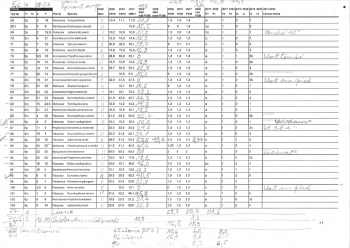Valorization of forest inventory data – the initial step: treating and integrating the data to a shared database [General topic]

A fieldsheet which was completed in the forest with measurements taken on the trees and other complementary observations.
Click here to enlarge the picture
The measurement gathered on the permanent plots can be valorized in many ways by the researchers. Their analysis teaches us, inter alia, about the growth rates of the ligneous species, the tree mortality and regeneration patterns, the carbon turnover of the ecosystem, or the consequences of anthropogenic pressure and the climate change on the forest dynamics.
This information is embodied in the trees and the first step is harvesting it by writing it down on paper (as shown on the figure above). The fieldsheets contain the raw data and a long treatment process still separates them from a final product such as a scientific paper. On average, 400 trees require individual attention per hectare and for each one of them the data must then be manually digitized and integrated in an Excel file. The scientific rigor demands that the information is then inspected to highlight outliers or uncertainties. Algorithms and automatically applied formulas help the scientist to speed up this process. These clean raw data are then ready to be studied.
Our approach is to conduct the post-field data handling accordingly to the RAINFOR protocol. The whole methodology is well documented and available on their website. Once the data have been conformed to these standards, they are uploaded to ForestPlots.NET to strengthen the existing database for rainforests across the tropics.
Keywords: forest inventory, post-field data handling, RAINFOR, ForestPlots.NET, Congo basin, carbon stocks, carbon fluxes.
Félix Laurent, 15/06/2020
